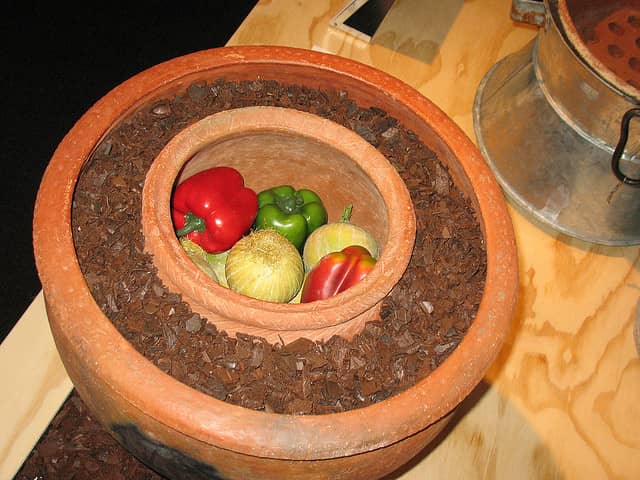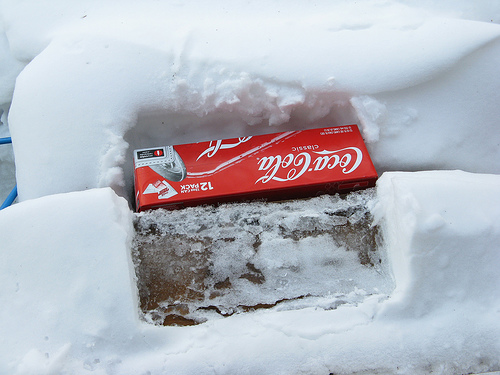Three Natural Refrigeration Techniques for Every Season
Agnieszka Spieszny 11.11.11

Depending on your location and available means of refrigeration, you might find the advice below practical and useful. I’ve outlined three different techniques for keeping perishable foods cold without the use of electricity or any other power source. Natural refrigeration is a wonder that saves resources, but its downfall is that the correct materials and landscape/climate must be available to make these techniques work.
In hot, dry weather:
Make a zeer pot. A zeer pot, or pot-in-pot refrigerator, is a makeshift refrigerator that does not use electricity but is cooled by evaporation. It consists of two pots, one placed inside the other with a layer of wet sand between the two pots. Covered with a wet cloth, the zeer pot cools the contents in the inner pot when evaporation draws liquid heat out from the inside.
Zeer pots are commonly used in poor communities especially in Africa where electricity is not available and the need to refrigerate food greatly improves the quality of life for the village inhabitants.
To make and use a zeer pot, secure two pots of different sizes so that one pots fits nicely in the other with a thick layer of wet sand in between the two pots. A layer of two to three inches is sufficient. A word on pot material – it must be porous, therefore clay or other earthen pots are recommended. And at least the inner pot must be unglazed. Glass and metal are not porous and will not work as a zeer pot because the water cannot seep out through tiny pores like those found in clay and will not cool the contents. Zeer pots depend on evaporation as the water needs to absorb heat to turn to vapor. Cover your zeer pot with a wet cloth.
The zeer pot needs reliable ventilation to be able to evaporate water. Also, to keep this process going, the sand and cloth must be rewetted. Add water to the sand twice a day, but keep the pot in a dry, well-ventilated area. This type of refrigeration system will not work well in climates with high humidity since water cannot evaporate easily in such climates.
In hot, humid weather:
I got this tip from Dick Proenneke, the man famous for the movie Alone in the Wilderness. Proenneke is a master craftsman and naturalist who filmed himself single-handedly building a cabin and all its fixings in the wilderness of Alaska.
Proenneke’s experiences in the wild were written and recorded. In More Readings From One Man’s Wilderness, he writes about using the underbelly of moss as a natural refrigerator, “We had cut out a section of moss and buried the halibut, herring and eggs. The ground still froze solid under that best of insulation…. White with frost under the moss.” Temperatures varied, but Proenneke experienced temperatures of 40 degrees below the moss.
This technique requires you to be in an area that grows thick moss and where the ground is soft enough for you to dig out a hole the size of which will suit your refrigeration needs. Cut deep enough into the moss so that the roots stay intact with the immediate layer of ground the moss is growing out of. Cut any shape and pull out the whole bed of moss. Dig a small hole just deep enough to fit your items and cover them back up with the moss to continue the natural insulation.
In cold weather:
Lucky you, you’ve got natural refrigeration already available to you. Now, you just need to put a few common sense tips to use.
If there is no snow on the ground, but the temperature is still chilly, bury your food below a tree. Just be careful of where you leave your food in nature. Remember, animals have a strong sense of smell and will be happy to steal your food. A tree evaporates water that it catches from the ground through its leaves. To get the water to evaporate, it takes the heat from the area below thus making it just slightly cooler. Remember to find a tree that does not see much sunlight.
Make sure that your food is secure from animals in a bag that’s tied to a tree or secured to the ground. Just as a precaution, if dangerous animals are present, keep your food stored at least 100 yards away from where you sleep.
Otherwise, bury your food in snow, but be sure to wrap your food in a water-proof layer, like a tarp, so that outside moisture does not come in contact with your food otherwise it could ruin it rapidly. Be careful as some containers may crack or break under extremely low temperatures such as glass and plastic.
When refrigerating in snow, make sure your items are completely covered, the best idea is to dig out a hole one foot deep in the snow or ground and cover it with some earth first, then with snow. Definitely make sure your items and preferably your hole is out of the sunlight.




